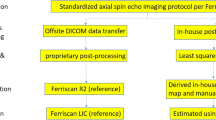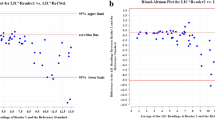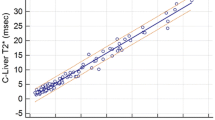Abstract
Background
Commercially available 3D multi-echo Dixon (mDixon) sequences provide parametric maps of liver T2*, obviating manual curve fitting that is often required with conventional gradient recalled echo (GRE)-based multi-echo relaxometry, potentially simplifying clinical work flow.
Objective
The purpose of our study was to compare T2* values generated by a 3D mDixon sequence to values generated by GRE-based T2* relaxometry with manual curve fitting in a pediatric and young adult population.
Materials and methods
We reviewed clinical MRI exams performed at 1.5T for liver iron content estimation between February 2015 and June 2016 that included both mDixon and multi-echo GRE pulse sequences. We obtained mean T2* measurements based on each sequence by drawing regions of interest on each of four axial slices through the mid-liver. We compared mDixon-based and GRE-based T2* measurements using paired t-tests and assessed agreement using single-measure intra-class correlation coefficients and Bland–Altman difference plots.
Results
One hundred nine patients met inclusion criteria (site 1=82; site 2=27). Mean age was 12.4±5.8 years, and 42 subjects (39%) were female. There was no statistically significant difference in mean T2* values for the two sequences (pooled means: 11.7±11.0 [GRE] vs. 11.7±10.9 ms [mDixon]; P=0.93). There was excellent absolute agreement between sequences (intraclass correlation coefficient [ICC]=0.98 for patients at both sites, confidence interval [CI]: 0.97–0.98 with mean bias of 0.0 ms [−4.2 ms to +4.2 ms]).
Conclusion
3D mDixon is accurate for measuring liver T2* and can likely replace 2D GRE-based relaxometry.




Similar content being viewed by others
References
Brown K, Subramony C, May W et al (2009) Hepatic iron overload in children with sickle cell anemia on chronic transfusion therapy. J Pediatr Hematol Oncol 31:309–312
Powell LW (2002) Diagnosis of hemochromatosis. Semin Gastrointest Dis 13(2):80–8
Brittenham GM, Badman DG (2003) Noninvasive measurement of iron: report of an NIDDK workshop. Blood 101:15–19
Sirlin CB, Reeder SB (2010) Magnetic resonance imaging quantification of liver iron. Magn Reson imaging Clin N Am 18:359–381
Olivieri NF, Brittenham GM (1997) Iron-chelating therapy and the treatment of thalassemia. Blood 89:739–761
Towbin AJ, Serai SD, Podberesky DJ (2013) Magnetic resonance imaging of the pediatric liver: imaging of steatosis, iron deposition, and fibrosis. Magn Reson Imaging Clin N Am 21:669–680
Wood JC (2014) Use of magnetic resonance imaging to monitor iron overload. Hematol Oncol Clin N Am 28:747–764
Serai SD, Fleck RJ, Quinn CT et al (2015) Retrospective comparison of gradient recalled echo R2* and spin-echo R2 magnetic resonance analysis methods for estimating liver iron content in children and adolescents. Pediatr Radiol 45:1629–1634
St Pierre TG, Clark PR, Chua-anusorn W et al (2005) Noninvasive measurement and imaging of liver iron concentrations using proton magnetic resonance. Blood 105:855–861
Wood JC, Enriquez C, Ghugre N et al (2005) MRI R2 and R2* mapping accurately estimates hepatic iron concentration in transfusion-dependent thalassemia and sickle cell disease patients. Blood 106:1460–1465
Gandon Y, Olivie D, Guyader D et al (2004) Non-invasive assessment of hepatic iron stores by MRI. Lancet 363:357–362
Hankins JS, McCarville MB, Loeffler RB et al (2009) R2* magnetic resonance imaging of the liver in patients with iron overload. Blood 113:4853–4855
Sofue K, Mileto A, Dale BM et al (2015) Interexamination repeatability and spatial heterogeneity of liver iron and fat quantification using MRI-based multistep adaptive fitting algorithm. J Magn Reson Imaging 42:1281–1290
Horng DE, Hernando D, Reeder SB (2017) Quantification of liver fat in the presence of iron overload. J Magn Reson Imaging 45:428–439
Idilman IS, Aniktar H, Idilman R et al (2013) Hepatic steatosis: quantification by proton density fat fraction with MR imaging versus liver biopsy. Radiology 267:767–775
Idilman IS, Keskin O, Celik A et al (2016) A comparison of liver fat content as determined by magnetic resonance imaging-proton density fat fraction and MRS versus liver histology in non-alcoholic fatty liver disease. Acta Radiol 57:271–278
Kuhn JP, Hernando D, Munoz del Rio A et al (2012) Effect of multipeak spectral modeling of fat for liver iron and fat quantification: correlation of biopsy with MR imaging results. Radiology 265:133–142
Serai SD, Dillman JR, Trout AT (2017) Proton density fat fraction measurements at 1.5- and 3-T hepatic MR imaging: same-day agreement among readers and across two imager manufacturers. Radiology 284:244–254
McBride GB (2005) A proposal for strength-of-agreement criteria for Lin’s concordance correlation coefficient. National Institute of Water & Atmospheric Research, Hamilton
Anderson LJ, Westwood MA, Holden S et al (2004) Myocardial iron clearance during reversal of siderotic cardiomyopathy with intravenous desferrioxamine: a prospective study using T2* cardiovascular magnetic resonance. Br J Haematol 127:348–355
Henninger B, Zoller H, Kannengiesser S et al (2017) 3D multiecho Dixon for the evaluation of hepatic iron and fat in a clinical setting. J Magn Reson Imaging 46:793–800
Acknowledgments
This work was presented at the Society for Pediatric Radiology annual meeting, May 2017, Vancouver, BC, Canada and at the Society of Computed Body Tomography and Magnetic Resonance annual meeting, September 2017, Nashville, TN.
Author information
Authors and Affiliations
Corresponding author
Ethics declarations
Conflicts of interest
None
Rights and permissions
About this article
Cite this article
Serai, S.D., Smith, E.A., Trout, A.T. et al. Agreement between manual relaxometry and semi-automated scanner-based multi-echo Dixon technique for measuring liver T2* in a pediatric and young adult population. Pediatr Radiol 48, 94–100 (2018). https://doi.org/10.1007/s00247-017-3990-y
Received:
Revised:
Accepted:
Published:
Issue Date:
DOI: https://doi.org/10.1007/s00247-017-3990-y




